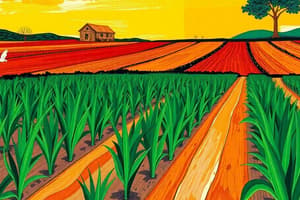Podcast
Questions and Answers
What is the term for growing multiple crops together on the same land?
What is the term for growing multiple crops together on the same land?
- Monoculture
- Agroforestry
- Organic farming
- Polyculture (correct)
Why is it important to consider the local climate when selecting crops?
Why is it important to consider the local climate when selecting crops?
- To reduce pest and disease pressure
- To reduce the need for irrigation
- To ensure the crops are suitable for the local climate and soil conditions (correct)
- To increase crop yields
What is the purpose of tillage in soil preparation?
What is the purpose of tillage in soil preparation?
- To control weeds
- To add nutrients to the soil
- To control pests and diseases
- To break up and aerate the soil (correct)
What is the main goal of integrated pest management (IPM) techniques?
What is the main goal of integrated pest management (IPM) techniques?
What is the main purpose of pruning in crop management?
What is the main purpose of pruning in crop management?
What is the main goal of grading and packaging in the harvesting and post-harvest stage?
What is the main goal of grading and packaging in the harvesting and post-harvest stage?
Flashcards are hidden until you start studying
Study Notes
Crop Production
Types of Crop Production:
- Monoculture: growing a single crop on a large area of land
- Polyculture: growing multiple crops together on the same land
- Agroforestry: integrating trees into agricultural landscapes
- Organic farming: using natural methods to control pests and diseases, and avoiding synthetic fertilizers and pesticides
Crop Selection:
- Climate: choosing crops suitable for the local climate and soil conditions
- Soil type: selecting crops that thrive in the existing soil type
- Market demand: growing crops that are in demand and profitable
- Crop rotation: rotating crops to maintain soil fertility and reduce pests and diseases
Crop Management
Soil Preparation:
- Tillage: breaking up and aerating the soil to prepare it for planting
- Fertilization: adding nutrients to the soil to promote healthy plant growth
- Irrigation: controlling water supply to crops to optimize growth
Crop Maintenance:
- Weed control: managing weeds to prevent competition with crops
- Pest management: controlling pests using integrated pest management (IPM) techniques
- Disease management: using cultural, chemical, and biological methods to control diseases
- Pruning: trimming or removing plant parts to promote healthy growth and fruiting
Harvesting and Post-Harvest:
- Maturity: determining the optimal time to harvest crops
- Handling: carefully handling crops to minimize damage and spoilage
- Storage: storing crops in a way that maintains quality and extends shelf life
- Grading and packaging: sorting and preparing crops for market distribution
Types of Crop Production
- Monoculture involves growing a single crop on a large area of land
- Polyculture involves growing multiple crops together on the same land
- Agroforestry integrates trees into agricultural landscapes
- Organic farming uses natural methods to control pests and diseases and avoids synthetic fertilizers and pesticides
Crop Selection
- Climate affects crop selection, with crops chosen to suit local conditions
- Soil type is a factor in crop selection, with crops chosen to thrive in existing soil
- Market demand is a consideration in crop selection, with profitable crops preferred
- Crop rotation is used to maintain soil fertility and reduce pests and diseases
Soil Preparation
- Tillage breaks up and aerates the soil to prepare it for planting
- Fertilization adds nutrients to the soil to promote healthy plant growth
- Irrigation controls water supply to crops to optimize growth
Crop Maintenance
- Weed control manages weeds to prevent competition with crops
- Pest management uses integrated pest management (IPM) techniques to control pests
- Disease management uses cultural, chemical, and biological methods to control diseases
- Pruning trims or removes plant parts to promote healthy growth and fruiting
Harvesting and Post-Harvest
- Maturity determines the optimal time to harvest crops
- Handling crops carefully minimizes damage and spoilage
- Storage maintains crop quality and extends shelf life
- Grading and packaging sorts and prepares crops for market distribution
Studying That Suits You
Use AI to generate personalized quizzes and flashcards to suit your learning preferences.




